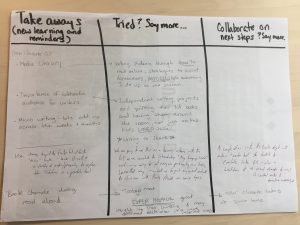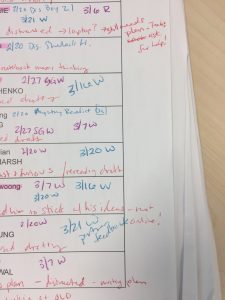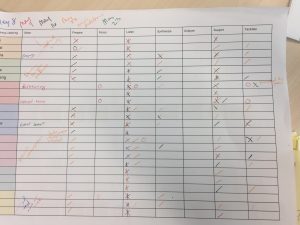Keeping the Momentum Up After Professional Learning
 How many times have you attended a great professional learning event and left with all kinds of ideas that you wanted to try only to find that list, untouched the next year when you are cleaning out your desk? Or maybe you did try a new tool or strategy but quickly slipped back into the business of your daily routine and forgot to come back to it. This happens to all of us.
How many times have you attended a great professional learning event and left with all kinds of ideas that you wanted to try only to find that list, untouched the next year when you are cleaning out your desk? Or maybe you did try a new tool or strategy but quickly slipped back into the business of your daily routine and forgot to come back to it. This happens to all of us.
This year, one of the questions I have kept at the front of my mind is, “How can we help teachers keep the momentum gained during professional learning up once they return to their normal routines?”
One way we can do this is to bring teachers back together to share and collaborate on next steps. It would be fantastic if our budgets allowed for this additional time, but most of us don’t have that luxury. As a workaround, I suggest offering teachers some nice food.
Here are my steps for trying this out:
- I looked at possible times when teachers might be able to get together two weeks after a weekend conference.
- I emailed a teacher in each section of the school (all very different schedules) and ask for their input on three possible meeting times.
- From their feedback, I choose the best time.
- I sent out calendar invites for all the teachers who attended:
“I’d like to invite you to an informal sharing and collaboration with the participants from ReThinking Literacy. This is an opportunity for us to share our takeaways and try-its with each other, to collaborate on possible next steps, and encourage each other.
I’ll have a few light breakfast snacks to share; please bring your own coffee or tea.
Looking forward to learning more together!”
- I made multiple copies of a three column chart: Take Aways (new learning and reminders), Tried? Say more…, Collaborate on next steps? Say more…
- I emailed those who said they were coming and those who hadn’t yet responded the day before with a reminder and a note that I was baking muffins.
- In the morning, I pulled a few of my tables together to create a shared table for ten people, set out the food and the charts, and turned on some music.
- As teachers came in, we chatted a bit then I invited them to work with someone or on their own (it was 7:30 am after all) to add to the charts, making sure to include their names so we could follow up.
- After about 10 minutes, we rotated charts, read, and added new thinking.


- Throughout, some teachers shared ideas with the whole group or with just a partner.
- Everyone expressed interest in visiting each other’s classes to see some of this new learning in action.
- Next, I typed up their charts and shared them with the group.
- As the Literacy Coach, I now have several places to follow up with this group of teachers.
How do you keep up the momentum after professional learning? Do you have strategies that work for you as a learner? For you as a leader?


 Recently, I noticed that one of my grade eight classes did not have the same strong community feel that my other class had. I used the same class list to record the students’ sports, activities, and service groups they were involved in. This helped me group students for English work who might already have a relationship from their afterschool activities. It also provided a quick cheat sheet for me to check in more casually with students as they came into class early.
Recently, I noticed that one of my grade eight classes did not have the same strong community feel that my other class had. I used the same class list to record the students’ sports, activities, and service groups they were involved in. This helped me group students for English work who might already have a relationship from their afterschool activities. It also provided a quick cheat sheet for me to check in more casually with students as they came into class early.  About once or twice in a unit, I will create a paper class checklist. Right now, I have one to help me record students’ speaking and listening skills in their book club conversations. Again, I use a different color each class and note the date in that color. I know these are little snapshots, so I am not looking for everything every time. I have a coding system I learned from a colleague many years ago: / is evidence and I add to it with each additional attempt. 0 means the student is struggling and I need to support them.
About once or twice in a unit, I will create a paper class checklist. Right now, I have one to help me record students’ speaking and listening skills in their book club conversations. Again, I use a different color each class and note the date in that color. I know these are little snapshots, so I am not looking for everything every time. I have a coding system I learned from a colleague many years ago: / is evidence and I add to it with each additional attempt. 0 means the student is struggling and I need to support them. In the previous unit, Literary Essay, I created a paper class checklist to help me quickly note what students were and were not yet doing in their essays (they wrote three). Then I pulled small groups to give feedback and teach. This is so much more efficient than writing up feedback for students. Also, by giving feedback in small groups, I get to teach them with a model and see right then as they try it if they are getting it or still need more support.
In the previous unit, Literary Essay, I created a paper class checklist to help me quickly note what students were and were not yet doing in their essays (they wrote three). Then I pulled small groups to give feedback and teach. This is so much more efficient than writing up feedback for students. Also, by giving feedback in small groups, I get to teach them with a model and see right then as they try it if they are getting it or still need more support.